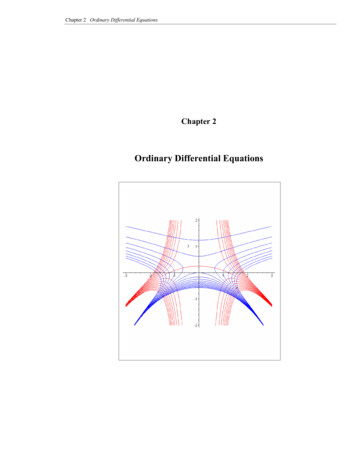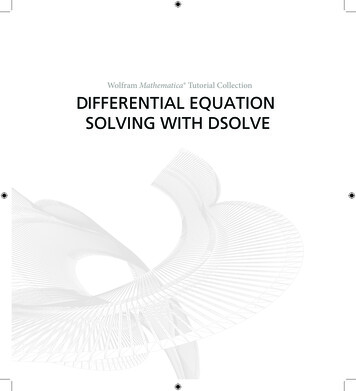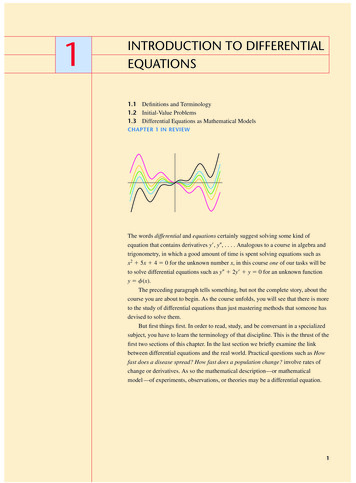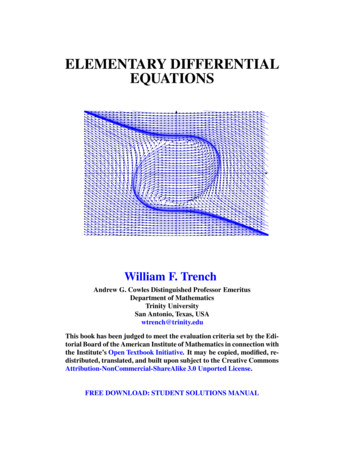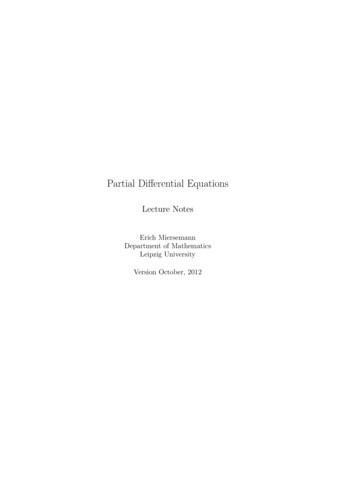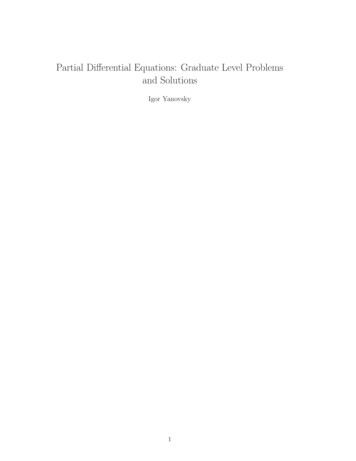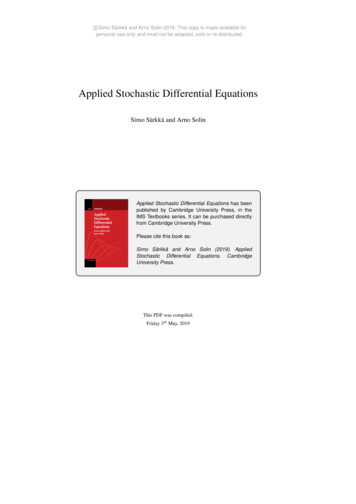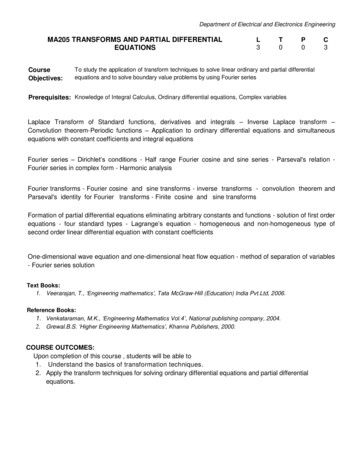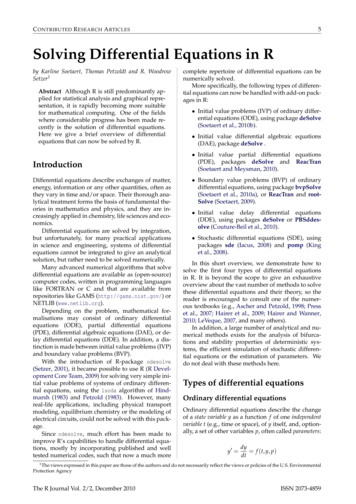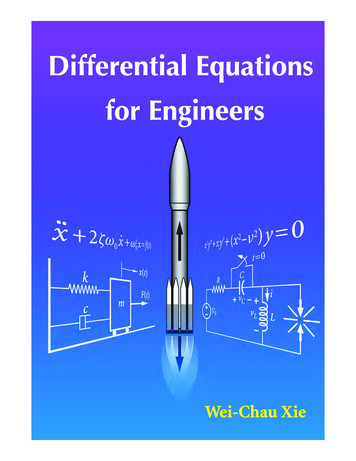
Transcription
DIFFERENTIAL EQUATIONS FOR ENGINEERSThis book presents a systematic and comprehensive introduction to ordinary differentialequations for engineering students and practitioners. Mathematical concepts and varioustechniques are presented in a clear, logical, and concise manner. Various visual features areused to highlight focus areas. Complete illustrative diagrams are used to facilitatemathematical modeling of application problems. Readers are motivated by a focus on therelevance of differential equations through their applications in various engineeringdisciplines. Studies of various types of differential equations are determined by engineeringapplications. Theory and techniques for solving differential equations are then applied tosolve practical engineering problems. Detailed step-by-step analysis is presented to modelthe engineering problems using differential equations from physical principles and to solvethe differential equations using the easiest possible method. Such a detailed, step-by-stepapproach, especially when applied to practical engineering problems, helps the readers todevelop problem-solving skills.This book is suitable for use not only as a textbook on ordinary differential equations forundergraduate students in an engineering program but also as a guide to self-study. It canalso be used as a reference after students have completed learning the subject.Wei-Chau Xie is a Professor in the Department of Civil and Environmental Engineeringand the Department of Applied Mathematics at the University of Waterloo. He is theauthor of Dynamic Stability of Structures and has published numerous journal articles ondynamic stability, structural dynamics and random vibration, nonlinear dynamics andstochastic mechanics, reliability and safety analysis of engineering systems, and seismicanalysis and design of engineering structures. He has been teaching differential equationsto engineering students for almost twenty years. He received the Teaching ExcellenceAward in 2001 in recognition of his exemplary record of outstanding teaching, concern forstudents, and commitment to the development and enrichment of engineering educationat Waterloo. He is the recipient of the Distinguished Teacher Award in 2007, which is thehighest formal recognition given by the University of Waterloo for a superior record ofcontinued excellence in teaching.
Differential Equations for EngineersWei-Chau XieUniversity of Waterloo
cambridge university pressCambridge, New York, Melbourne, Madrid, Cape Town, Singapore,São Paulo, Delhi, Dubai, TokyoCambridge University Press32 Avenue of the Americas, New York, NY 10013-2473, USAwww.cambridge.orgInformation on this title: www.cambridge.org/9780521194242 Wei-Chau Xie 2010This publication is in copyright. Subject to statutory exceptionand to the provisions of relevant collective licensing agreements,no reproduction of any part may take place without the writtenpermission of Cambridge University Press.First published 2010Printed in the United States of AmericaA catalog record for this publication is available from the British Library.Library of Congress Cataloging in Publication dataXie, Wei-Chau, 1964–Differential equations for engineers / Wei-Chau Xie.p. cm.Includes bibliographical references and index.ISBN 978-0-521-19424-21. Differential equations. 2. Engineering mathematics.TA347.D45X54 2010620.001 515352–dc222010001101I. Title.ISBN 978-0-521-19424-2 HardbackCambridge University Press has no responsibility for thepersistence or accuracy of URLs for external or third-party InternetWeb sites referred to in this publication and does not guarantee thatany content on such Web sites is, or will remain, accurate orappropriate.
ContentsPreface . . . . . . . . . . . . . . . . . . . . . . . . . . . . . . . . . . . xiii1 1.11.22 2.12.22.32.4Introduction . . . . . . . . . . . . . . . . . . . . . . . . . . . .1Motivating Examples1General Concepts and Definitions6First-Order and Simple Higher-Order Differential Equations .16The Method of Separation of Variables16Method of Transformation of Variables202.2.1Homogeneous Equations202.2.2Special Transformations25Exact Differential Equations and Integrating Factors312.3.1Exact Differential Equations322.3.2Integrating Factors392.3.3Method of Inspection452.3.4Integrating Factors by Groups48Linear First-Order Equations552.4.1Linear First-Order Equations552.4.2Bernoulli Differential Equations582.5Equations Solvable for the Independent or Dependent Variable612.6Simple Higher-Order Differential Equations682.72.6.1Equations Immediately Integrable682.6.2The Dependent Variable Absent702.6.3The Independent Variable Absent72SummaryProblems3 3.17478Applications of First-Order and Simple Higher-Order Equations 87Heating and Cooling873.2Motion of a Particle in a Resisting Medium913.3Hanging Cables97vii
viiicontents3.3.1The Suspension Bridge973.3.2Cable under Self-Weight1023.4Electric Circuits1083.5Natural Purification in a Stream1143.6Various Application Problems120Problems4 4.14.24.3130Linear Differential Equations . . . . . . . . . . . . . . . . . . . 140General Linear Ordinary Differential Equations140Complementary Solutions1434.2.1Characteristic Equation Having Real Distinct Roots1434.2.2Characteristic Equation Having Complex Roots1474.2.3Characteristic Equation Having Repeated Roots151Particular Solutions1534.3.1Method of Undetermined Coefficients1534.3.2Method of Operators1624.3.3Method of Variation of Parameters1734.4Euler Differential Equations1784.5Summary180Problems5 5.1183Applications of Linear Differential Equations . . . . . . . . . .188Vibration of a Single Degree-of-Freedom System1885.1.1Formulation—Equation of Motion1885.1.2Response of a Single Degree-of-Freedom System1935.1.2.1Free Vibration—Complementary Solution1935.1.2.2Forced Vibration—Particular Solution2005.2Electric Circuits2095.3Vibration of a Vehicle Passing a Speed Bump2135.4Beam-Columns2185.5Various Application Problems223Problems6 6.1232The Laplace Transform and Its Applications . . . . . . . . . . . 244The Laplace Transform244
contentsix6.2The Heaviside Step Function2496.3Impulse Functions and the Dirac Delta Function2546.4The Inverse Laplace Transform2576.5Solving Differential Equations Using the Laplace Transform2636.6Applications of the Laplace Transform2686.76.6.1Response of a Single Degree-of-Freedom System2686.6.2Other Applications2756.6.3Beams on Elastic Foundation283Summary289Problems7 7.17.2291Systems of Linear Differential Equations. . . . . . . . . . . .300Introduction300The Method of Operator3047.2.1Complementary Solutions3047.2.2Particular Solutions3077.3The Method of Laplace Transform3187.4The Matrix Method3257.57.4.1Complementary Solutions3267.4.2Particular Solutions3347.4.3Response of Multiple Degrees-of-Freedom Systems344Summary7.5.1The Method of Operator3477.5.2The Method of Laplace Transform3487.5.3The Matrix Method349Problems8 8.1347351Applications of Systems of Linear Differential Equations . . .357Mathematical Modeling of Mechanical Vibrations3578.2Vibration Absorbers or Tuned Mass Dampers3668.3An Electric Circuit3728.4Vibration of a Two-Story Shear Building3778.4.1Free Vibration—Complementary Solutions3788.4.2Forced Vibration—General Solutions380Problems384
xcontents9 9.1Series Solutions of Differential Equations . . . . . . . . . . . . 390Review of Power Series3919.2Series Solution about an Ordinary Point3949.3Series Solution about a Regular Singular Point403Bessel’s Equation and Its Applications4089.3.19.3.1.19.3.29.4Solutions of Bessel’s EquationApplications of Bessel’s EquationSummaryProblems1010.1408418424426Numerical Solutions of Differential Equations . . . . . . . . .431Numerical Solutions of First-Order Initial Value Problems43110.1.1 The Euler Method or Constant Slope Method43210.1.2 Error Analysis43410.1.3 The Backward Euler Method43610.1.4 Improved Euler Method—Average Slope Method43710.1.5 The Runge-Kutta Methods44010.2 Numerical Solutions of Systems of Differential Equations44510.3 Stiff Differential Equations44910.4 Summary452Problems4541111.1Partial Differential Equations . . . . . . . . . . . . . . . . . . . 457Simple Partial Differential Equations45711.2 Method of Separation of Variables45811.3 Application—Flexural Motion of Beams46511.3.1Formulation—Equation of Motion46511.3.2 Free Vibration46611.3.3 Forced Vibration47111.4 Application—Heat Conduction47311.4.1 Formulation—Heat Equation47311.4.2 Two-Dimensional Steady-State Heat Conduction47611.4.3 One-Dimensional Transient Heat Conduction48011.4.4 One-Dimensional Transient Heat Conduction on a Semi-InfiniteInterval483
contentsxi11.4.5 Three-Dimensional Steady-State Heat Conduction48811.5 Summary492Problems4931212.1Solving Ordinary Differential Equations Using Maple . . . . . 498Closed-Form Solutions of Differential Equations499Simple Ordinary Differential Equations49912.1.2 Linear Ordinary Differential Equations50612.1.3 The Laplace Transform50712.1.4 Systems of Ordinary Differential Equations50912.1.112.2 Series Solutions of Differential Equations51212.3 Numerical Solutions of Differential Equations517Problems526Appendix ATables of Mathematical Formulas . . . . . . . . . . . . .531a.1Table of Trigonometric Identities531a.2Table of Derivatives533a.3Table of Integrals534a.4Table of Laplace Transforms537a.5Table of Inverse Laplace Transforms539Index . . . . . . . . . . . . . . . . . . . . . . . . . . . . . . . . . . . .542
PrefaceBackgroundDifferential equations have wide applications in various engineering and sciencedisciplines. In general, modeling of the variation of a physical quantity, such astemperature, pressure, displacement, velocity, stress, strain, current, voltage, orconcentration of a pollutant, with the change of time or location, or both wouldresult in differential equations. Similarly, studying the variation of some physicalquantities on other physical quantities would also lead to differential equations.In fact, many engineering subjects, such as mechanical vibration or structuraldynamics, heat transfer, or theory of electric circuits, are founded on the theory ofdifferential equations. It is practically important for engineers to be able to modelphysical problems using mathematical equations, and then solve these equations sothat the behavior of the systems concerned can be studied.I have been teaching differential equations to engineering students for the pasttwo decades. Most, if not all, of the textbooks are written by mathematicianswith little engineering background. Based on my experience and feedback fromstudents, the following lists some of the gaps frequently seen in current textbooks: A major focus is put on explaining mathematical conceptsFor engineers, the purpose of learning the theory of differential equations isto be able to solve practical problems where differential equations are used.For engineering students, it is more important to know the applications andtechniques for solving application problems than to delve into the nuances ofmathematical concepts and theorems. Knowing the appropriate applications canmotivate them to study the mathematical concepts and techniques. However,it is much more challenging to model an application problem using physicalprinciples and then solve the resulting differential equations than it is to merelycarry out mathematical exercises. Insufficient emphasis is placed on the step-by-step problem solving techniquesEngineering students do not usually have the same mathematical backgroundand interest as students who major in mathematics. Mathematicians are moreinterested if: (1) there are solutions to a differential equation or a system ofdifferential equations; (2) the solutions are unique under a certain set of conditions; and (3) the differential equations can be solved. On the other hand,xiii
xivprefaceengineers are more interested in mathematical modeling of a practical problemand actually solving the equations to find the solutions using the easiest possiblemethod. Hence, a detailed step-by-step approach, especially applied to practicalengineering problems, helps students to develop problem solving skills. Presentations are usually formula-driven with little variation in visual designIt is very difficult to attract students to read boring formulas without variationof presentation. Readers often miss the points of importance.ObjectivesThis book addresses the needs of engineering students and aims to achieve thefollowing objectives: To motivate students on the relevance of differential equations in engineeringthrough their applications in various engineering disciplines. Studies of varioustypes of differential equations are motivated by engineering applications; theory and techniques for solving differential equations are then applied to solvepractical engineering problems. To have a balance between theory and applications. This book could be used as areference after students have completed learning the subject. As a reference, it hasto be reasonably comprehensive and complete. Detailed step-by-step analysis ispresented to model the engineering problems using differential equations andto solve the differential equations. To present the mathematical concepts and various techniques in a clear, logicaland concise manner. Various visual features, such as side-notes (preceded bythesymbol), different fonts and shades, are used to highlight focus areas.Complete illustrative diagrams are used to facilitate mathematical modeling ofapplication problems. This book is not only suitable as a textbook for classroomuse but also is easy for self-study. As a textbook, it has to be easy to understand.For self-study, the presentation is detailed with all necessary steps and usefulformulas given as side-notes.ScopeThis book is primarily for engineering students and practitioners as the mainaudience. It is suitable as a textbook on ordinary differential equations for undergraduate students in an engineering program. Such a course is usually offered inthe second year after students have taken calculus and linear algebra in the firstyear. Although it is assumed that students have a working knowledge of calculusand linear algebra, some important concepts and results are reviewed when they arefirst used so as to refresh their memory.
prefacexvChapter 1 first presents some motivating examples, which will be studied indetail later in the book, to illustrate how differential equations arise in engineering applications. Some basic general concepts of differential equations are thenintroduced.In Chapter 2, various techniques for solving first-order and simple higher-orderordinary differential equations are presented. These methods are then applied inChapter 3 to study various application problems involving first-order and simplehigher-order differential equations.Chapter 4 studies linear ordinary differential equations. Complementary solutions are obtained through the characteristic equations and characteristic numbers.Particular solutions are obtained using the method of undetermined coefficients,the operator method, and the method of variation of parameters. Applicationsinvolving linear ordinary differential equations are presented in Chapter 5.Solutions of linear ordinary differential equations using the Laplace transformare studied in Chapter 6, emphasizing functions involving Heaviside step functionand Dirac delta function.Chapter 7 studies solutions of systems of linear ordinary differential equations.The method of operator, the method of Laplace transform, and the matrix methodare introduced. Applications involving systems of linear ordinary differential equations are considered in Chapter 8.In Chapter 9, solutions of ordinary differential equations in series about anordinary point and a regular singular point are presented. Applications of Bessel’sequation in engineering are considered.Some classical methods, including forward and backward Euler method, improved Euler method, and Runge-Kutta methods, are presented in Chapter 10 fornumerical solutions of ordinary differential equations.In Chapter 11, the method of separation of variables is applied to solve partialdifferential equations. When the method is applicable, it converts a partial differential equation into a set of ordinary differential equations. Flexural vibration ofbeams and heat conduction are studied as examples of application.Solutions of ordinary differential equations using Maple are presented in Chapter12. Symbolic computation software, such as Maple, is very efficient in solvingproblems involving ordinary differential equations. However, it cannot replacelearning and thinking, especially mathematical modeling. It is important to developanalytical skills and proficiency through “hand” calculations, as has been done inprevious chapters. This will also help the development of insight into the problemsand appreciation of the solution process. For this reason, solutions of ordinarydifferential equations using Maple is presented in the last chapter of the bookinstead of a scattering throughout the book.
xviprefaceThe book covers a wide range of materials on ordinary differential equationsand their engineering applications. There are more than enough materials for aone-term (semester) undergraduate course. Instructors can select the materialsaccording to the curriculum. Drafts of this book were used as the textbook in aone-term undergraduate course at the University of Waterloo.AcknowledgmentsFirst and foremost, my sincere appreciation goes to my students. It is the studentswho give me a stage where I can cultivate my talent and passion for teaching. It isfor the students that this book is written, as my small contribution to their successin academic and professional careers. My undergraduate students who have usedthe draft of this book as a textbook have made many encouraging comments andconstructive suggestions.I am very grateful to many people who have reviewed and commented on thebook, including Professor Hong-Jian Lai of West Virginia University, Professors S.T.Ariaratnam, Xin-Zhi Liu, Stanislav Potapenko, and Edward Vrscay of the Universityof Waterloo.My graduate students Mohamad Alwan, Qinghua Huang, Jun Liu, Shunhao Ni,and Richard Wiebe have carefully read the book and made many helpful and criticalsuggestions.My sincere appreciation goes to Mr. Peter Gordon, Senior Editor, Engineering,Cambridge University Press, for his encouragement, trust, and hard work to publishthis book.Special thanks are due to Mr. John Bennett, my mentor, teacher, and friend, forhis advice and guidance. He has also painstakingly proofread and copyedited thisbook.Without the unfailing love and support of my mother, who has always believed inme, this work would not have been possible. In addition, the care, love, patience, andunderstanding of my wife Cong-Rong and lovely daughters Victoria and Tiffanyhave been of inestimable encouragement and help. I love them very much andappreciate all that they have contributed to my work.I appreciate hearing your comments through email (xie@uwaterloo.ca) or regular correspondence.Wei-Chau XieWaterloo, Ontario, Canada
CH1APTERIntroduction1.1Motivating ExamplesDifferential equations have wide applications in various engineering and sciencedisciplines. In general, modeling variations of a physical quantity, such as temperature, pressure, displacement, velocity, stress, strain, or concentration of a pollutant,with the change of time t or location, such as the coordinates (x, y, z), or bothwould require differential equations. Similarly, studying the variation of a physical quantity on other physical quantities would lead to differential equations. Forexample, the change of strain on stress for some viscoelastic materials follows adifferential equation.It is important for engineers to be able to model physical problems using mathematical equations, and then solve these equations so that the behavior of the systemsconcerned can be studied.In this section, a few examples are presented to illustrate how practical problemsare modeled mathematically and how differential equations arise in them.Motivating Example 1First consider the projectile of a mass m launched with initial velocity v0 at angleθ0 at time t 0, as shown.θθv0θ0Ov(t)yv(t)yAxβvxmg1
21 introductionThe atmosphere exerts a resistance force on the mass, which is proportionalto the instantaneous velocity of the mass, i.e., R β v, where β is a constant,and is opposite to the direction of the velocity of the mass. Set up the Cartesiancoordinate system as shown by placing the origin at the point from where the massm is launched. At time t, the mass is at location x(t), y(t) . The instantaneous velocity of themass in the x- and y-directionsare ẋ(t) and ẏ(t), respectively. Hence the velocity 22of the mass is v(t) ẋ (t) ẏ (t) at the angle θ(t) tan 1 ẏ(t)/ẋ(t) .The mass is subjected to two forces: the vertical downward gravity mg and theresistance force R(t) βv(t).The equations of motion of the mass can be established using Newton’s Second Law: F ma. The x-component of the resistance force is R(t) cos θ(t). Inthe y-direction, the component of the resistance force is R(t) sin θ(t). Hence,applying Newton’s Second Law yields x-direction: max Fxm ẍ(t) R(t) cos θ(t), m ÿ(t) mg R(t) sin θ(t).y-direction: may FySinceθ (t) tan 1ẏ(t)ẋ(t) ẋ(t),cos θ 2ẋ (t) ẏ 2 (t)ẏ(t)sin θ ,2ẋ (t) ẏ 2 (t)the equations of motion becomem ẍ(t) βv(t) · ẋ(t)ẋ 2 (t) ẏ 2 (t)ẏ(t)m ÿ(t) mg βv(t) · 2ẋ (t) ẏ 2 (t) m ẍ(t) β ẋ(t) 0, m ÿ(t) β ẏ(t) mg,in which the initial conditions are at time t 0: x(0) 0, y(0) 0, ẋ(0) v0 cos θ0 ,ẏ(0) v0 sin θ0 . The equations of motion are two equations involving the first- andsecond-order derivatives ẋ(t), ẏ(t), ẍ(t), and ÿ(t). These equations are called, aswill be defined later, a system of two second-order ordinary differential equations.Because of the complexity of the problems, in the following examples, the problems are described and the governing equations are presented without detailedderivation. These problems will be investigated in details in later chapters whenapplications of various types of differential equations are studied.Motivating Example 2A tank contains a liquid of volume V (t), which is polluted with a pollutant concentration in percentage of c(t) at time t. To reduce the pollutant concentration, an
1.1 motivating examples3inflow of rate Qin is injected to the tank. Unfortunately, the inflow is also pollutedbut to a lesser degree with a pollutant concentration cin . It is assumed that theinflow is perfectly mixed with the liquid in the tank instantaneously. An outflowof rate Qout is removed from the tank as shown. Suppose that, at time t 0, thevolume of the liquid is V0 with a pollutant concentration of c0 .InflowQ in , c inVolume V(t)Concentration c(t)OutflowQout , c(t)The equation governing the pollutant concentration c(t) is given by V0 (Qin Qout )t dc(t)dt Qin c(t) Qin cin ,with initial condition c(0) c0 . This is a first-order ordinary differential equation.Motivating Example 3Hanger CableDeckyxOw(x)Consider the suspension bridge as shown, which consists of the main cable, thehangers, and the deck. The self-weight of the deck and the loads applied on thedeck are transferred to the cable through the hangers.
41 introductionSet up the Cartesian coordinate system by placing the origin O at the lowest pointof the cable. The cable can be modeled as subjected to a distributed load w(x). Theequation governing the shape of the cable is given byd2 yw(x), 2dxHwhere H is the tension in the cable at the lowest point O. This is a second-orderordinary differential equation.Motivating Example 4Reference positionmx(t)cx0(t)ky(t)Consider the vibration of a single-story shear building under the excitation ofearthquake. The shear building consists of a rigid girder of mass m supported bycolumns of combined stiffness k. The vibration of the girder can be described bythe horizontal displacement x(t). The earthquake is modeled by the displacementof the ground x0 (t) as shown. When the girder vibrates, there is a damping forcedue to the internal friction between various components of the building, given by c ẋ(t) ẋ0 (t) , where c is the damping coefficient.The relative displacement y(t) x(t) x0 (t) between the girder and the groundis governed by the equationm ÿ(t) c ẏ(t) k y(t) m ẍ0 (t),which is a second-order linear ordinary differential equation.Motivating Example 5In many engineering applications, an equipment of mass m is usually mounted ona supporting structure that can be modeled as a spring of stiffness k and a damperof damping coefficient c as shown in the following figure. Due to unbalanced massin rotating components or other excitation mechanisms, the equipment is subjectedto a harmonic force F0 sin t. The vibration of the mass is described by the vertical displacement x(t). When the excitation frequency is close to ω0 k/m, whichis the natural circular frequency of the equipment and its support, vibration of largeamplitudes occurs.
1.1 motivating examples5In order to reduce the vibration of the equipment, a vibration absorber ismounted on the equipment. The vibration absorber can be modeled as a massma , a spring of stiffness ka , and a damper of damping coefficient ca . The vibrationof the absorber is described by the vertical displacement xa (t).xa(t)maF0 sin ructureThe equations of motion governing the vibration of the equipment and theabsorber are given bym ẍ (c ca ) ẋ (k ka )x ca ẋa ka xa F0 sin t,ma ẍa ca ẋa ka xa ca ẋ ka x 0,which comprises a system of two coupled second-order linear ordinary differentialequations.Motivating Example 6PUtPt 0EI, ρAxLvA bridge may be modeled as a simply supported beam of length L, mass densityper unit length ρA, and flexural rigidity EI as shown. A vehicle of weight P crossesthe bridge at a constant speed U . Suppose at time t 0, the vehicle is at the left endof the bridge and the bridge is at rest. The deflection of the bridge is v(x, t), whichis a function of both location x and time t. The equation governing v(x, t) is thepartial differential equationρA 2 v(x, t) 4 v(x, t) EI P δ(x U t), t 2 x 4
422 first-order and simple higher-order differential equations2.19Example 2.19y (cos3 x y sin x)dx cos x (sin x cos x 2 y)dy 0.SolveThe differential equation is of the standard form M dx N dy 0, whereM(x, y) y cos3 x y 2 sin x,N(x, y) sin x cos2 x 2 y cos x.Test for exactness: M cos3 x 2 y sin x, y M N y x N cos3 x 2 sin2 x cos x 2 y sin x, x The differential equation is not exact.Since1 M N N y x (cos3 x 2 y sin x) (cos3 x 2 sin2 x cos x 2 y sin x)sin x cos2 x 2 y cos x2 sin x (2 y sin x cos x)2 sin x ,A function of x onlycos x (2 y sin x cos x)cos x"! 2 sin x N1 M dx expdxμ(x) expN y xcos x 11 exp 2d(cos x) exp 2 ln cos x .cos xcos2 x Multiplying the differential equation by the integrating factor μ(x) 1yieldscos2 xy 2 sin x2ydy 0.dx sin x cos2 xcos xy cos x The general solution is determined using the method of grouping terms y cos x dxdx) sin x dy y sin xF y2ydycos xdy y 2 sin xdxcos2 x Ey2cos x xwhich givesy sin x y2 C.cos xGeneral solution 0,
1203 applications of first-order and simple higher-order equationsProcedure for Solving an Application Problem1. Establish the governing differential equations based on physical principlesand geometrical properties underlying the problem.2. Identify the type of these differential equations and then solve them.3. Determine the arbitrary constants in the general solutions using the initialor boundary conditions.Example 3.10 — Ferry Boat3.103.6 Various Application ProblemsA ferry boat is crossing a river of width a from point A to point O as shown in thefollowing figure. The boat is always aiming toward the destination O. The speed ofthe river flow is constant vR and the speed of the boat is constant vB . Determinethe equation of the path traced by the boat.yRiver FlowvRvB cosθP(x, y)vBvB sinθyθAxOaHxSuppose that, at time t, the boat is at point P with coordinates (x, y). The velocityof the boat has two components: the velocity of the boat vB relative to the river flow(as if the river is not flowing), which is pointing toward the origin O or along linePO, and the velocity of the river vR in the y direction.Decompose the velocity components vB and vR in the x- and y-directionsvx vB cos θ ,Fromvy vR vB sin θ.OHP, it is easy to seecos θ OHx ,OPx 2 y 2sin θ yPH .OPx 2 y 2Hence, the equations of motion are given byvx xdx vB ,dtx 2 y 2vy ydy vR v B .dtx 2 y 2
3 applications of first-order and simple higher-order equationsExample 3.11 — Bar with Variable Cross-Section3.11122A bar with circular cross-sections is supported at the top end and is subjected to aload of P as shown in Figure 3.14(a). The length of the bar is L. The weight densityof the materials is ρ per unit volume. It is required that the stress at every point isconstant σa . Determine the equation for the cross-section of the bar.xxxydxLxP W(x)yyP(a)P(b)xy(c)Figure 3.14 A bar under axial load.Consider a cross-section at level x as shown in Figure 3.14(b). The correspondingradius is y. The volume of a circular disk of thickness dx is dV πy 2 dx. Thevolume of the segment of bar between 0 and x is xV (x) πy 2 dx,0and the weight of this segment is W (x) ρV (x) ρxπy 2 dx.0The load applied on cross-section at level x is equal to the sum of the externallyapplied load P and the weight of the segment between 0 and x, i.e., xF(x) W (x) P ρπy 2 dx P.0The normal stress isσ (x) F(x)1 ρA(x)πy 2 0x πy 2 dx P σa ρ0xπy 2 dx P σa πy 2 .Differentiating with respect to x yieldsρπy 2 σa π · 2 ydy
undergraduate students in an engineering program but also as a guide to self-study. It can also be used as a reference after students have completed learning the subject. Wei-Chau Xie is a Professor in the Department of Civil and Environmental Engineering and the Department of Applied Mathematics at the University of Waterloo. He is the

